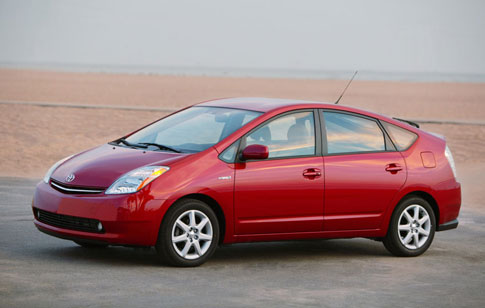I’m in Los Angeles this week and I was astounded at the number of Prius hybrid electric cars on the road. It is easily the most popular model in California and it is officially Toyota’s top seller in the United States. While this site is mainly dedicated to fully electric powered vehicles, I thought I’d dedicate a section to the hybrid movement we are seeing on the American roads today. I don’t think they are the end all solution to the energy crisis, but you have to walk before you can run, and America is walking finally. Some people might be confused about how, exactly, these cars work and I thought I’d clarify them a little.
Parallel Hybrid Electric Vehicles (HEV)

HEVs, such as the Honda Civic Hybrid and the Toyota Prius have become hugely popular in the United States for their fuel economy and unlimited range. These cars are technically known as parallel electric hybrids because they utilize two sources of power at the same time, and electric motor and internal combustion engine. This means both power sources can be utilized at the same time to give the car easier, faster acceleration, like the K1 Attack, which goes 0-60 in 3 seconds when utilizing both power sources. OR as parallel hybrids are more conventionally used in the Prius, the electric motor is utilized while the combustion engine is completely off at speeds 0-40 mph because it provides more responsive torque and no gas whatsoever. In an internal combustion engine (ICE) vehicle, most gas is consumed from 0-40 during acceleration, so parallel hybrids get better gas mileage in the city. The internal combustion engine is used at speeds above 40 mph because it provides a higher top speed, and requires less gas than normal because it doesn’t need as much torque or gas at consistent highway speeds. The internal combustion engine can also drive the car at low speeds when the battery is low. This doesn’t happen often, because when the vehicle brakes, the kinetic energy is captured by letting the wheels turn the alternator which powers the battery, this is known as regenerative braking.
Serial Plug-In Hybrid Electric Vehicles (PHEV)

As of now, plug-in hybrid electric vehicles are not yet produced. The Chevy Volt concept is a serial hybrid electric vehicle. These cars rely purely on an electric motor to power the wheels. The Volt will potentially get 40 miles on a charge (hence, PHEV-40), then for any driving after that, a combustion engine will kick in, not to power the wheels, but to act as a generator that recharges the battery. The Volt likely has such a low ev range because GM did not want to sacrifice performance for electric power. PHEV’s can utilize regenerative braking just like HEV’s. Thus, you get the near unlimited driving range from the established gasoline infrastructure for long trips, but you can potentially go weeks without ever having to utilize the combustion engine for your daily commute.
Electric cars are potentially superior to all of these because they do not utilize antiquated internal combustion engines at all. The parts and fluids used to manage an internal combustion engine is staggering compared to the lightweight, energy efficient electric motor. The criticism of the electric car is the idea that batteries have not yet developed enough. But because of their wide range of applications, battery technologies are advancing at a swift pace; while ICE technology has been at a relative standstill for decades. And when companies such as GM say the technology is not there, you need to keep in mind that exact same company came out with a completely viable electric car in the late 90’s, the EV1, using lead acid batteries, before lithium-ion, before the potential revolutionary EEstor. But hey, thanks to the popularity of hybrids we are now walking in the right direction.






